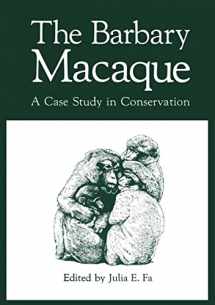
The Barbary Macaque: A Case Study in Conservation
ISBN-13:
9780306417337
ISBN-10:
0306417332
Edition:
1984
Author:
Julia E. Fa
Publication date:
1984
Publisher:
Springer
Format:
Hardcover
386 pages
Category:
Conservation
,
Nature & Ecology
,
Social Sciences
,
Sociology
FREE US shipping
Book details
ISBN-13:
9780306417337
ISBN-10:
0306417332
Edition:
1984
Author:
Julia E. Fa
Publication date:
1984
Publisher:
Springer
Format:
Hardcover
386 pages
Category:
Conservation
,
Nature & Ecology
,
Social Sciences
,
Sociology
Summary
The Barbary Macaque: A Case Study in Conservation (ISBN-13: 9780306417337 and ISBN-10: 0306417332), written by authors
Julia E. Fa, was published by Springer in 1984.
With an overall rating of 3.9 stars, it's a notable title among other
Conservation
(Nature & Ecology, Social Sciences, Sociology) books. You can easily purchase or rent The Barbary Macaque: A Case Study in Conservation (Hardcover) from BooksRun,
along with many other new and used
Conservation
books
and textbooks.
And, if you're looking to sell your copy, our current buyback offer is $0.3.
Description
The Barbary macaque (all too often mistakenly called an ape) was first brought to the attention of the Conservation Working Party of the Primate Society of Great Britain late 1979 when John Fa reported that 'surplus' animals were being sent from Gibraltar to dubious locations, such as an Italian safari park. Since there had been no scientific input into the Army's management of the monkey colony on Gibraltar, and there was concern about inbreeding, nutrition and health - about the long-term viability of the colony, it was felt that the Society could help. The Gibraltar Scientific Authority and the Army were very receptive to our offer and ideas, and this topic occupied successive chairmen over the last few years - Robin Dunbar and Richard Wrangham, myself and now Miranda Stevenson - with constant prompting and help from John Fa. Considerations soon extended to the status of the species as a whole, so that there have been three main aspects:- (1) the improved health of a larger self-sustaining population on Gibraltar, (2) the status and behavioural biology of natural populations in North Africa (Morocco and Algeria), and (3) the breeding achievements in European parks and zoos, and their potential for reintroduction to suitable areas in North Africa, along with other possibilities. Robin Dunbar organized the compilation of recommendations for managing the Gibraltar colony with regard to numbers, age-sex struc ture and behavioural relationships, with some observations on diet to avoid obesity and infertility.


We would LOVE it if you could help us and other readers by reviewing the book
Book review

Congratulations! We have received your book review.
{user}
{createdAt}
by {truncated_author}


